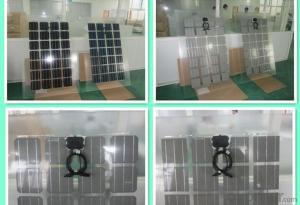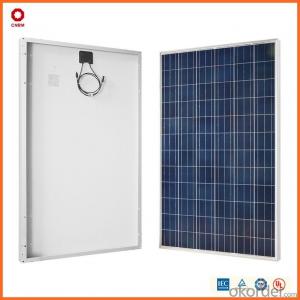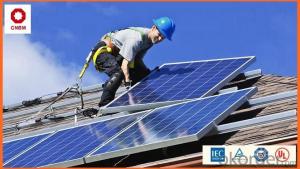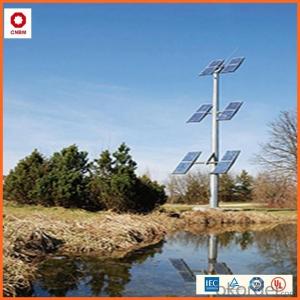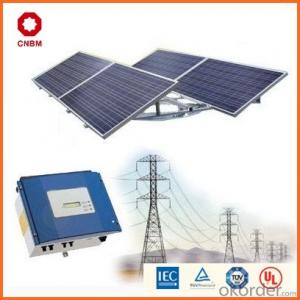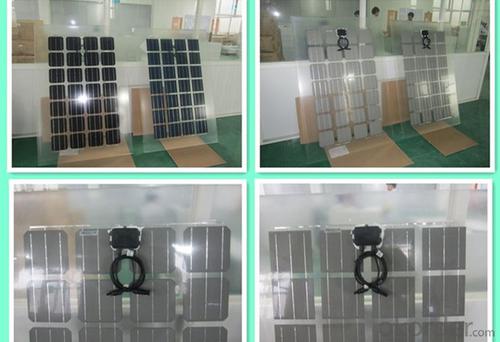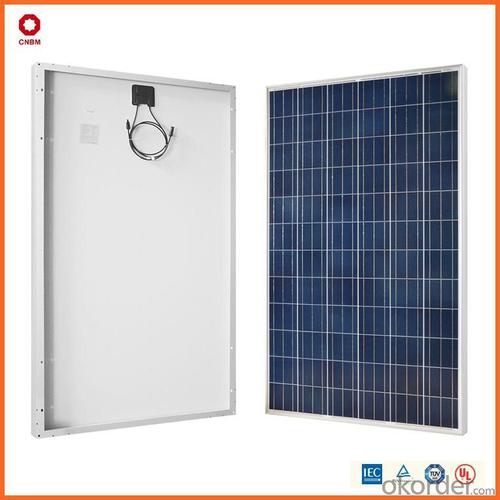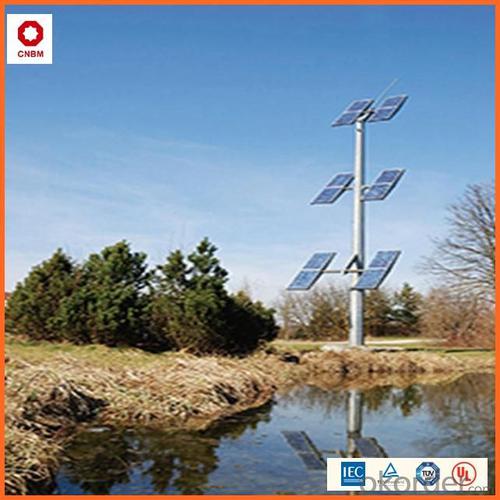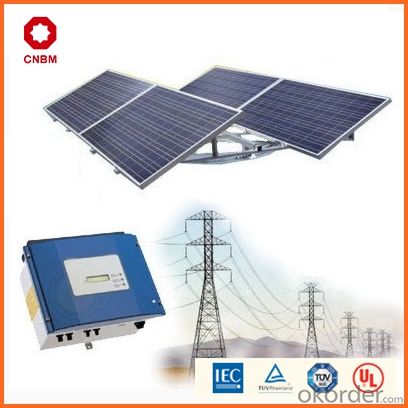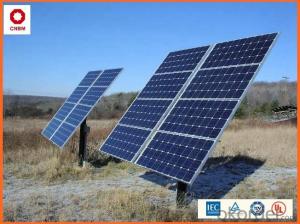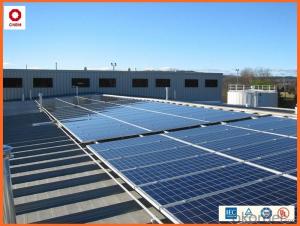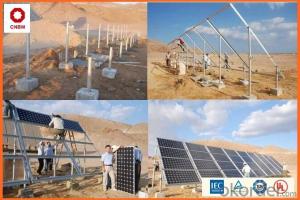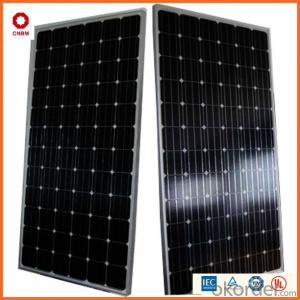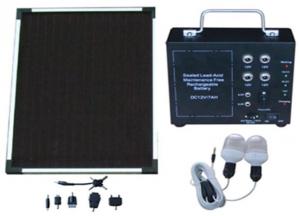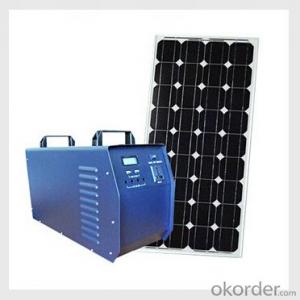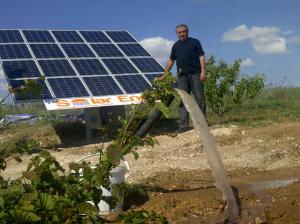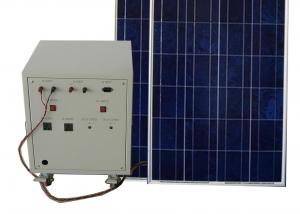60w Small Solar Panels for Solar Energy Systems Homes - In Stock China Manufacturer
- Loading Port:
- China main port
- Payment Terms:
- TT OR LC
- Min Order Qty:
- 1 watt
- Supply Capability:
- 10000000 watt/month
OKorder Service Pledge
OKorder Financial Service
You Might Also Like
Specification
Product Description:
Hot Sale !!! Quality and Safety of Small Poly Solar Panel 5w~150w
1. Rigorous quality control meets the highest international standards.
2. High-transmissivity low-iron tempered glass, strong aluminium frame.
3. Using UV-resistant silicon.
4. IS09001/14001/CE/TUV/UL
Warranties of Small Poly Solar Panel 35~85w
1. 10 years limited product warranty
2. 15 years at 90% of the minimal rated power output
3. 25 years at 80% of the minimal rated power output
Specification
Characteristics of Poly solar panels CNBM (245-320W) | |||||
Max Power Voltage Vmp(V) | 30.3 | 30.8 | 31.1 | 31.4 | 31.85 |
Max Power Current Imp(A) | 7.60 | 7.64 | 7.73 | 7.81 | 7.85 |
Open Circuit Voltage Voc(V) | 36.1 | 36.6 | 37 | 37.3 | 37.68 |
Short Circuit Current Isc(A) | 8.50 | 8.55 | 8.65 | 8.75 | 8.85 |
Max Power Pm(W) | 230W | 235W | 240W | 245W | 250W |
Temperature Coefficient of Cells Poly solar panels CNBM (245-320W) | |
NOCT | 45± 2 |
Temperature Coeffucients of Isc | 0.0492 |
Temperature Coeffucients of Voc | -0.3374 |
Temperature Coeffucients of Voc | -0.4677 |
Mechanical Data of Poly solar panels CNBM (245-320W) | |
Dimension | 1638 × 982 × 40 mm |
Weight | 19.5 kg |
No. of Cells and Connections | 60 (6 ×10) |
Tolerance | 0 ~ + 5 W |
Cell | Monocrystalline Cell 156 × 156 mm |
Packing | 624 Pcs/40ft(H) Container |
Limits of Poly solar panels CNBM (245-320W) | |
Operating Temperature | -40 to +85 |
Storage Temperature | -40 to +85 |
Max System Voltage | 1000VDC(IEC) / 600VDC(UL) |
Features of our products:
• High conversion efficiency mono/poly-crystalline amorphous silicon solar cells
• Modules incorporate high performance bypass diodes to minimize the power drop caused by shading
• High transmittance, low-iron tempered glass
• High performance EVA encapsulant to prevent destroying and water.
• AI frame: without screw, corner connection. 8 holes on the frame can be installed easily
• Good performance of preventing from atrocious weather such as wind and hails
• Certifications: CE IEC TUV VDE UL, Class I
• 10 years 90% power output warranty
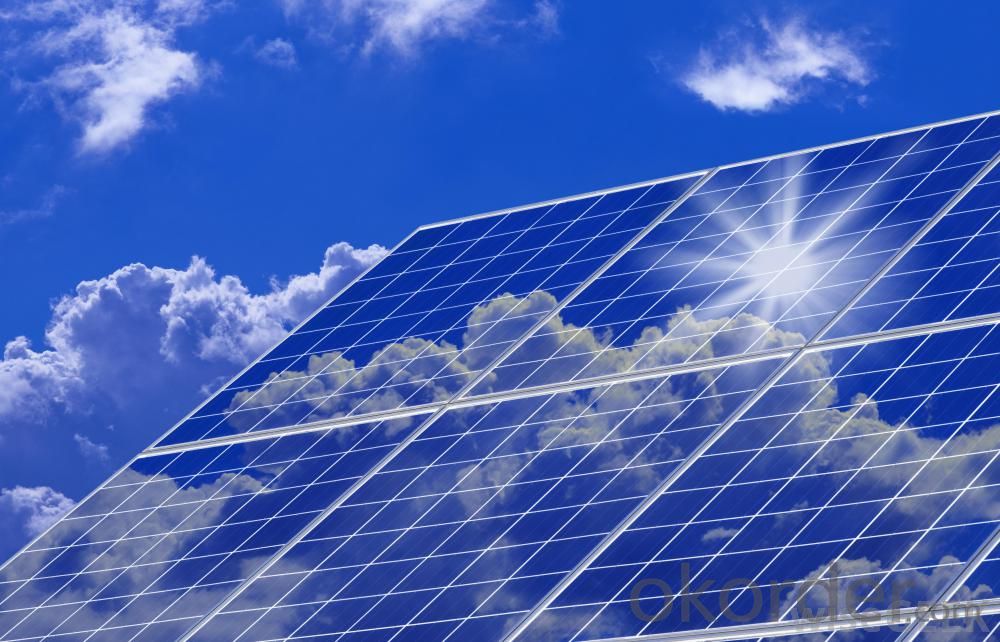
Shipping of Small Poly Solar Panel 35~85w
By Sea | Delivery from Shanghai or Ningbo seaport |
By Air | Departure from Shanghai Pudong Airport |
By Express | Post by DHL, EMS, UPS, TNT. |
Features of our products:
• High conversion efficiency mono/poly-crystalline amorphous silicon solar cells
• Modules incorporate high performance bypass diodes to minimize the power drop caused by shading
• High transmittance, low-iron tempered glass
• High performance EVA encapsulant to prevent destroying and water.
• AI frame: without screw, corner connection. 8 holes on the frame can be installed easily
• Good performance of preventing from atrocious weather such as wind and hails
• Certifications: CE IEC TUV VDE UL, Class I
• 10 years 90% power output warranty
As a professional Solar Panel manufacturer and Supplier in China, we have our customers come around the whole world and our specialization has got a worldwide recognition. Meanwhile, with our superior quality, competitive price, prompt and excellent service, As main role in trade section of CNBM Group, CNBM International Corporation supplies products including Monocrystalline Solar Panel, Polycrystalline Solar Panel ( multicrystalline silicon Solar Panel) have received and enjoyed famous reputation in many countries and regions in the world.
- Q: Can solar energy systems be used in powering scientific research vessels or marine laboratories?
- Yes, solar energy systems can definitely be used to power scientific research vessels or marine laboratories. Solar energy is a renewable and sustainable source of power that can be harnessed using photovoltaic panels or solar thermal collectors. Research vessels and marine laboratories require a significant amount of energy to carry out their operations, which often includes scientific experiments, data collection, and analysis. These activities typically involve equipment such as computers, sensors, and lab instruments that require a constant and reliable source of power. Solar energy systems can be installed on these vessels or laboratories to provide a clean and efficient source of electricity. The photovoltaic panels convert sunlight into electricity, which can then be used to power the various equipment and systems onboard. Additionally, excess energy produced by the solar panels can be stored in batteries for use during periods of low sunlight or at night. Utilizing solar energy in these marine environments offers several advantages. First, it reduces the dependence on fossil fuels and minimizes the carbon footprint associated with traditional power generation methods. This is especially important in the context of scientific research, as it aligns with the principles of environmental sustainability and conservation. Second, solar energy systems provide a reliable and independent source of power. Research vessels and marine laboratories often operate in remote or isolated locations where access to traditional power grids may be limited or non-existent. By utilizing solar energy, these vessels and facilities can generate their own electricity and continue their research activities without relying on external power sources. Finally, solar energy systems are low-maintenance and have a long lifespan. Once installed, they require minimal upkeep and can withstand the harsh marine environment. This makes them well-suited for use in research vessels or marine laboratories, where downtime and maintenance issues can be disruptive to ongoing scientific projects. In conclusion, solar energy systems can certainly be used to power scientific research vessels or marine laboratories. They offer a sustainable, reliable, and independent source of electricity, reducing the carbon footprint and ensuring uninterrupted research activities even in remote locations.
- Q: Can solar energy systems be used for powering off-grid eco-farms?
- Yes, solar energy systems can definitely be used for powering off-grid eco-farms. Solar panels can be installed to harness sunlight and convert it into electricity, which can then be used to power various farm operations such as irrigation systems, lighting, ventilation, and machinery. This renewable energy source is ideal for off-grid eco-farms as it reduces dependence on fossil fuels, minimizes environmental impact, and offers a sustainable solution for meeting energy needs in remote farming locations.
- Q: Can solar panels be installed on canopies or awnings?
- Yes, solar panels can be installed on canopies or awnings. In fact, many businesses and homeowners choose to install solar panels on their canopies or awnings as it allows for dual functionality, providing shade and generating clean energy simultaneously. This installation method is particularly beneficial for places with limited roof space or those wanting to maximize their solar energy production.
- Q: Can solar energy systems be used for powering off-grid telecommunications networks?
- Yes, solar energy systems can be used to power off-grid telecommunications networks. Solar panels can generate electricity from sunlight and store it in batteries, providing a reliable and sustainable power source for remote or isolated locations where traditional power infrastructure is unavailable or unreliable. This makes solar energy an ideal solution for powering off-grid telecommunications networks, ensuring continuous connectivity and communication in remote areas.
- Q: Can solar energy systems be used in all locations?
- Solar energy systems can be used in most locations, but their efficiency and effectiveness may vary depending on factors such as sunlight availability, climate, and geographical location.
- Q: How does the efficiency of solar panels degrade over time?
- Solar panels' efficiency declines over time due to a variety of factors. One major cause is the gradual deterioration of the panel's components. Long-term exposure to sunlight, weather conditions, and temperature fluctuations can lead to the degradation of materials such as solar cells, electrical connections, and protective coatings. Another factor that contributes to the decrease in solar panel efficiency is the accumulation of dirt, dust, and debris on the panel's surface. These particles build up and create a barrier between the sunlight and the solar cells, reducing the amount of light that can be converted into electricity. Furthermore, the aging process of the materials used in the construction of solar panels can affect their performance. This can result in a decrease in the panel's ability to effectively absorb sunlight and convert it into electricity. Moreover, potential manufacturing defects or poor installation practices can also impact the efficiency of solar panels. Although these issues may not be immediately apparent, they can lead to a gradual decline in performance over time. It is important to note that the rate at which solar panel efficiency degrades can vary depending on factors such as panel quality, maintenance practices, and environmental conditions. Generally, most solar panels experience a modest degradation rate of approximately 0.5-1% per year. This means that after 25-30 years, the efficiency of the panels may decrease by around 20-30%. To minimize the degradation of solar panel efficiency, regular maintenance and cleaning are recommended. This includes periodically inspecting for any signs of damage, cleaning the surface to remove dirt and debris, and ensuring proper wiring and connections. Additionally, ongoing advancements in solar panel technology and manufacturing processes are continuously being made to enhance their longevity and overall performance.
- Q: What are the different types of solar panels used in solar energy systems?
- The different types of solar panels used in solar energy systems include monocrystalline, polycrystalline, and thin-film panels. Monocrystalline panels are made from a single crystal structure, which makes them highly efficient but also more expensive. Polycrystalline panels are made from multiple crystals, making them slightly less efficient but more cost-effective. Thin-film panels are made by depositing a thin layer of photovoltaic material onto a substrate, making them flexible and lightweight, but generally less efficient than crystalline panels.
- Q: What is the role of microinverters in a solar energy system?
- Microinverters play a crucial role in a solar energy system as they convert the direct current (DC) produced by individual solar panels into alternating current (AC) that can be used to power homes and businesses. Unlike traditional string inverters, microinverters are installed on each panel, allowing for better energy production and system performance, even in shaded or partially shaded areas. Additionally, microinverters enable real-time monitoring of each panel's performance, simplifying maintenance and troubleshooting processes.
- Q: How do solar energy systems impact the reliability of electricity supply during blackouts?
- The reliability of electricity supply during blackouts can be positively influenced by solar energy systems. Homeowners and businesses can access electricity even when the grid goes down if they have a properly installed solar energy system. This is because solar panels generate electricity from sunlight, making them independent of the traditional power grid. When the sun is shining during the day, solar panels can produce electricity to meet the electrical needs of a home or business. Any excess energy generated can be stored in batteries for later use. This stored energy can then be utilized at night or during power outages, ensuring a reliable source of electricity when the grid is down. Furthermore, solar energy systems can be equipped with an inverter and a smart system that allows them to disconnect from the grid in the event of a blackout. This process, known as islanding, allows the solar panels to continue generating electricity for local consumption while isolating themselves from the main power grid. This feature guarantees that solar-powered homes and businesses can continue operating even during grid outages. The reliability of solar energy systems during blackouts depends on the size and capacity of the system, as well as the amount of energy stored in the batteries. Larger solar systems with ample battery storage can provide extended periods of electricity supply during blackouts, while smaller systems may only offer power for a limited time. It is worth noting that the reliability of solar energy systems during blackouts also relies on regular maintenance and inspections. Ensuring that the solar panels, batteries, and other components are functioning properly will optimize their performance during power outages. In conclusion, solar energy systems significantly enhance the reliability of electricity supply during blackouts. They provide a sustainable and independent source of electricity, reducing reliance on the grid and increasing resilience in the face of power disruptions.
- Q: How does the cleanliness of solar panels affect their performance?
- The performance of solar panels is significantly impacted by their cleanliness. When solar panels are dirty or covered in dust, dirt, or other debris, their capacity to efficiently absorb sunlight is reduced. As a result, the amount of electricity generated by the panels decreases. Dust and dirt particles on solar panels form a layer that blocks sunlight from reaching the photovoltaic cells. This obstruction hinders the effective conversion of sunlight into electricity. Consequently, the panels produce less electricity, and their overall performance is compromised. Maintaining the optimal performance of solar panels requires regular cleaning and maintenance. By keeping the panels clean, you ensure that maximum sunlight reaches the cells, resulting in efficient energy conversion and increased electricity production. This is particularly crucial in areas with high levels of dust, pollen, or other airborne particles. Furthermore, dirty solar panels can lead to additional problems. Accumulated dirt can trap heat on the panel's surface, causing overheating and potential damage. It can also corrode the panels' surface or create scratches if not cleaned promptly, further impacting their performance and lifespan. To maintain the cleanliness of solar panels, it is advisable to clean them regularly, especially in dusty or polluted environments. This can be achieved using a soft brush or sponge with water and mild detergent, taking care not to scratch the surface. For larger installations, automated cleaning systems or specialized solar panel cleaning services may be employed. In conclusion, the cleanliness of solar panels directly affects their performance. By keeping them free from dirt and debris, you can maximize their ability to absorb sunlight, resulting in increased electricity production and improved efficiency. Regular cleaning and maintenance are essential for ensuring optimal performance and longevity of solar panels.
Send your message to us
60w Small Solar Panels for Solar Energy Systems Homes - In Stock China Manufacturer
- Loading Port:
- China main port
- Payment Terms:
- TT OR LC
- Min Order Qty:
- 1 watt
- Supply Capability:
- 10000000 watt/month
OKorder Service Pledge
OKorder Financial Service
Similar products
Hot products
Hot Searches
Related keywords
